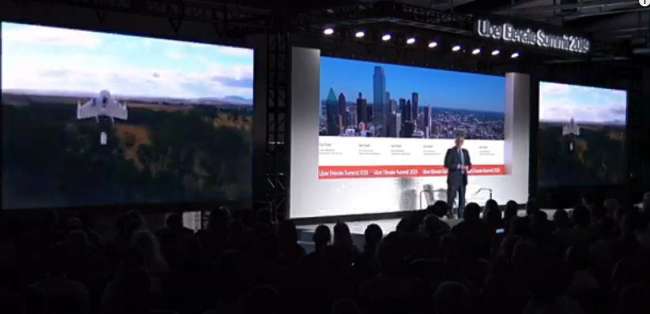Uber Tries to Steer Its Vision of Flying Cars Through Regulators

[Stay on top of transportation news: Get TTNews in your inbox.]
Uber Technologies Inc. is bringing its vision of a Jetsons’-like future of battery-powered flying vehicles for the masses to Washington, where it will have to Persuade regulators to approve this new model for how aviation works.
The company is betting that what the industry calls “urban air mobility” will become a major part of its transportation business in the future. As it opened a two-day Uber Elevate Summit 2019 on June 11, Eric Allison, who heads the Uber Elevate division, said growing congestion in cities is increasingly limiting the car-based trips the company sells.
“There’s an upper bound to what we can do on the ground,” Allison said. “We can move transportation off the grid and into the sky in a meaningful way.”
The company showed videos of a future in which hundreds of vehicles fly off urban landing ports and attendees of the conference could view multiple types of futuristic vehicles built by various companies, including some that are partners with Uber. Allison said the point of holding the conference in Washington was to focus on how government regulators will approve such designs.
You’ve seen what flying cars look like on the outside, but now you can see what the new models look like on the inside.
Tune in live to the #UberElevate Summit → https://t.co/MvGWfQCrCC pic.twitter.com/yj5OxafSkg — Uber (@Uber) June 11, 2019
So far, the pathway to the multiple approvals needed to certify these new vehicles and the airline-like companies that will operate them isn’t clear. While numerous companies have in recent years built prototypes capable of carrying people, none have developed a version that they’ve submitted to the Federal Aviation Administration for approval.
Even for traditional helicopters and planes, the highly regulated process of demonstrating an aircraft is capable of safely carrying people for hire takes years and costs tens of millions of dollars. For the new class of vehicles envisioned by Uber, which would fly robotically and rely on new materials and designs, some standards for approval don’t even exist yet.
“Yeah, there are some questions we have to resolve,” said Mike Romanowski, the FAA’s director of policy and innovation division. The FAA has made significant strides in becoming more flexible as a result of the rapidly growing drone industry, but challenges remain for larger-scale vehicles that aim to carry people, Romanowski said.
Some in attendance were optimistic that the system will adapt and approvals will happen quickly.
“We can do this and the time horizon is closer than people think,” said Pete Bunce, president of the General Aviation Manufacturers Association, a guest speaker at the event. “This is the most exciting time in aviation since the dawn of the jet age.”
For the time being, Uber is sticking with a more traditional approach to its aviation ambitions. Last week, it announced it was starting a service in New York City to fly people to John F. Kennedy International Airport that would use helicopters operated by an already-approved charter company.




